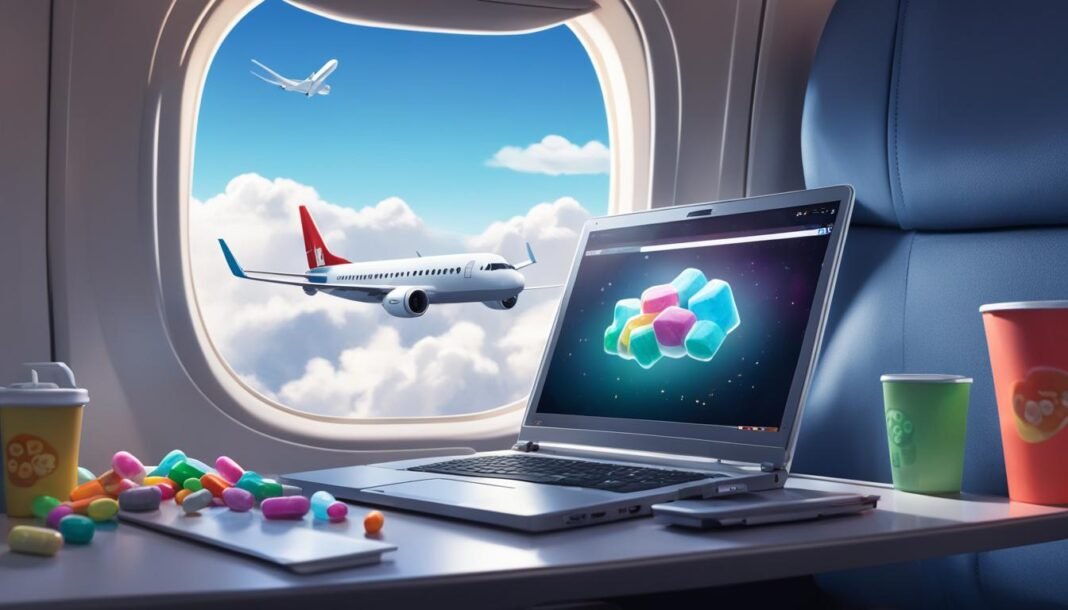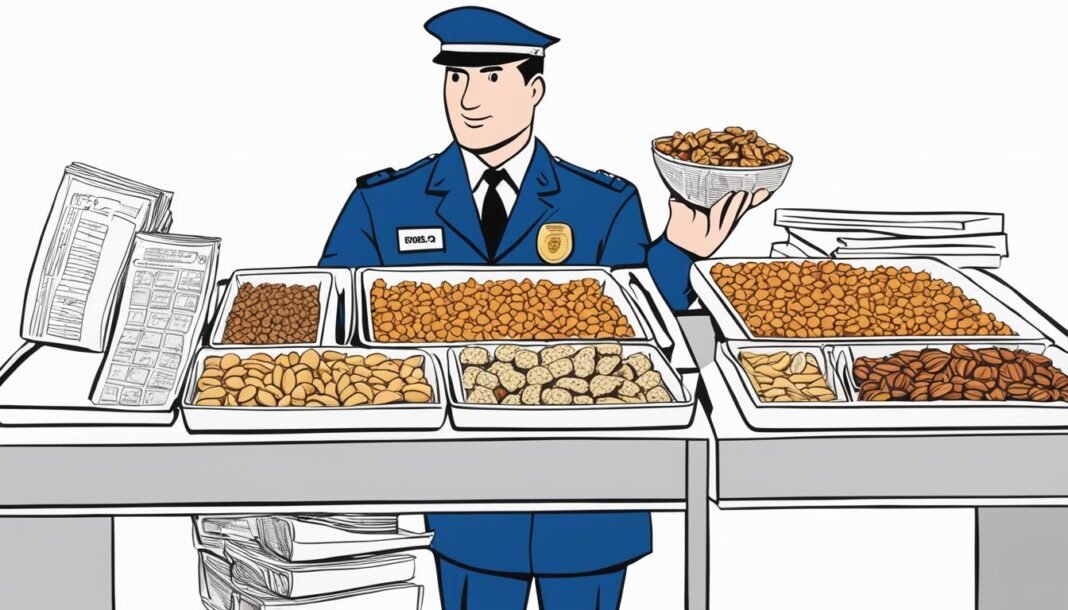Are you wondering whether you can bring your favorite snacks or homemade meals on a plane? Understanding the TSA guidelines regarding food restrictions is crucial to ensure a hassle-free travel experience.
While food is generally allowed on a plane, there are specific rules and restrictions that passengers need to be aware of.

Quick Answer
Can You Bring Food on a Plane?
Yes, you can bring food on a plane but you need to be aware of the TSA restrictions.
The Transportation Security Administration (TSA) considers formula, breast milk, toddler drinks, and baby/toddler food in quantities greater than 3.4 ounces or 100 milliliters as medically necessary liquids.
These items are allowed in carry-on bags and do not need to fit within a quart-sized bag. They can also be packed in checked bags without any issues.
It is important to let the TSA officer know at the beginning of the screening process if you are carrying these items. Ice packs, freezer packs, and other accessories required to cool formula and baby food are also allowed in carry-on bags.
Key Takeaways:
- Food is generally allowed on planes, but there are TSA guidelines and restrictions to be aware of.
- Formula, breast milk, toddler drinks, and baby/toddler food are considered medically necessary liquids and can be carried in quantities greater than 3.4 ounces or 100 milliliters.
- Inform the TSA officer if you are carrying these items and pack them in a way that is easily accessible for inspection.
- Ice packs and other cooling accessories for formula and baby food are allowed in carry-on bags.
- For the most up-to-date information, consult the TSA guidelines before packing your food items for air travel.
What Food is Allowed in Carry-On Bags?

In general, solid food items such as sandwiches, fruits, vegetables, and baked goods are permitted. These items can be a convenient and enjoyable way to keep yourself nourished during your journey.
However, it’s important to note that certain food items may require additional screening or may not be allowed through the security checkpoint if they raise security concerns or trigger an alarm. To ensure a smooth screening process, it’s crucial to pack these items in a way that they can be easily inspected by the Transportation Security Administration (TSA).
If you’re planning to bring snacks like sandwiches or baked goods, pack them in a clear plastic bag or container. This makes it easier for the TSA officers to see the contents during the screening process. It also helps prevent the need for additional inspection, ensuring a hassle-free experience.
Remember, the primary concern of the TSA is the safety and security of all passengers onboard. While most foods are allowed, there are restrictions in place to prevent any potential threats. By following the guidelines and packing your snacks thoughtfully, you can enjoy your favorite foods while complying with the TSA regulations.
Bringing Homemade Food on a Plane

Passengers are allowed to bring homemade food on a plane as long as it complies with TSA guidelines. Solid foods, such as sandwiches and baked goods, are generally allowed.
However, liquid or gel-like homemade items, such as soups or sauces, may be subject to the 3.4 ounces or 100 milliliters rule for carry-on liquids.
It is recommended to pack these items in leak-proof containers and consider freezing them before the flight to keep them cold for longer.
When bringing homemade food on a plane, it’s important to follow the TSA rules and regulations to ensure a smooth and hassle-free journey. Here are some key points to keep in mind:
- Check TSA Guidelines: Before packing homemade food, take some time to familiarize yourself with the latest TSA guidelines regarding airport food regulations. This will ensure that you are aware of any specific restrictions or requirements.
- Use Leak-Proof Containers: To prevent any spills or leaks during the flight, pack homemade food in leak-proof containers. This will help to avoid any potential mess and keep your belongings clean.
- Freeze Food Items: Consider freezing homemade food items before the flight. Not only will this help to keep them fresh, but it will also ensure that they remain within the TSA’s liquid restrictions. Remember to pack them in a well-insulated container or cooler bag to maintain their temperature.
- Label Containers: Properly label all containers with the contents and date of preparation. This will help you identify the food and ensure that it’s consumed within a safe timeframe.
| Pros | Cons |
|---|---|
|
|
Overall, bringing homemade food on a plane can be a convenient and cost-effective option for travelers who prefer to have a taste of home or who have specific dietary needs. Just ensure that you pack according to TSA guidelines to avoid any issues at the security checkpoint.
Tips for Packing Food for Air Travel

When packing food for air travel, there are a few important considerations to keep in mind.
Check TSA Guidelines
It’s crucial to stay up-to-date with the latest TSA guidelines regarding food items allowed on an airplane. TSA regulations can change, so it’s essential to review the official guidelines before you start packing. By doing so, you can avoid any surprises and ensure that you comply with current requirements.
Choose Easy-to-Open and Resealable Containers
When packing solid foods, opt for containers that are easy to open and reseal. Keep in mind that your items may need to be screened separately by TSA officers, so having quick and convenient access to your food will make the process smoother. Additionally, resealable containers help maintain freshness and prevent any spills or leaks during the flight.
Consider Reusable Containers or Bags
In an effort to reduce waste, consider using reusable containers or bags for your packed food. Not only is this an environmentally friendly option, but it also ensures that your food stays secure and protected. Look for airtight and leak-proof containers or bags to keep your food fresh and avoid any messes in your carry-on.
Pack Perishable Items in a Cooler Bag
If you plan to bring perishable items like sandwiches or salads, it’s advisable to pack them in a cooler bag. This will help maintain their freshness and ensure they stay at the appropriate temperature throughout your journey. Include ice packs in the cooler bag to keep the food chilled and ready to enjoy.
Avoid Strong Odors
When selecting foods to pack, be mindful of their odor. Avoid packing items with strong smells that may bother other passengers. Opt for snacks and meals that are relatively odorless or have minimal fragrance to ensure a pleasant experience for everyone onboard.
Special Considerations for Breast Milk and Baby Food
Breast milk and baby food are considered medically necessary liquids and are allowed in carry-on bags in quantities greater than 3.4 ounces or 100 milliliters.
One important thing to note is that your child doesn’t need to be present or traveling with you to bring breast milk or baby food.
It is highly recommended to inform the TSA officer at the beginning of the screening process. This will help smoothen the security check and prevent any unnecessary delays at the airport.
To make the screening process easier, it is advisable to transport breast milk and baby food in clear, translucent bottles.
This allows the TSA agents to visually inspect the contents without requiring you to open the containers. Additionally, ice packs and other accessories required to cool breast milk and baby food are also allowed in carry-on bags.
Remember, as a parent, you have certain rights and allowances when it comes to traveling with breast milk and baby food. Familiarize yourself with the TSA guidelines for bringing these items on a plane so that you can have a hassle-free journey while ensuring your child’s nutrition and comfort.
Continue Reading:
- Can You Bring SARMS on a Plane?
- Can You Bring Safety Pins on a Plane in 2024?
- Can You Bring Rocks on a Plane in 2024?
- Can You Bring Pepper Spray on a Plane in 2024?
- Can You Bring Nips on a Plane in 2024?
- Can You Bring Nicotine Gum on a Plane?
- Can You Bring Matches on a Plane? TSA Rules 2024
- Can You Bring Ice on a Plane?
- Can You Bring Handcuffs on a Plane?
- Travel Tips: Can You Bring Fruit on a Plane?
Frequently Asked Questions
Can you bring food on a plane?
According to TSA guidelines, food is generally allowed on a plane. However, there are certain restrictions and rules that passengers need to be aware of.
What food is allowed in carry-on bags?
Solid food items such as sandwiches, fruits, vegetables, and baked goods are allowed in carry-on bags. However, certain items may require additional screening or may not be allowed through the checkpoint if they trigger an alarm or raise security concerns.
Can you bring homemade food on a plane?
Yes, passengers are allowed to bring homemade food on a plane as long as it complies with TSA guidelines. Solid foods, such as sandwiches and baked goods, are generally allowed. However, liquid or gel-like homemade items, such as soups or sauces, may be subject to the 3.4 ounces or 100 milliliters rule for carry-on liquids.
What are tips for packing food for air travel?
When packing food for air travel, it is important to consider a few tips. First, make sure to check the TSA guidelines for the most up-to-date information on what food items are allowed. Pack solid foods in containers that are easy to open and reseal, as they may need to be screened separately. Consider using reusable containers or bags to reduce waste. If you are bringing perishable items, like sandwiches or salads, pack them in a cooler bag with ice packs to keep them fresh. Avoid packing foods with strong odors, as they may bother other passengers.
Are there special considerations for breast milk and baby food?
Yes, breast milk and baby food are considered medically necessary liquids and are allowed in carry-on bags in quantities greater than 3.4 ounces or 100 milliliters. It is not necessary for the child to be present or traveling with you to bring these items. However, it is recommended to inform the TSA officer at the beginning of the screening process if you are carrying breast milk or baby food. It is also advisable to transport these liquids in clear, translucent bottles for easier screening. Ice packs and other accessories required to cool breast milk and baby food are also allowed in carry-ons.


